engine YAMAHA YBR125 2004 User Guide
[x] Cancel search | Manufacturer: YAMAHA, Model Year: 2004, Model line: YBR125, Model: YAMAHA YBR125 2004Pages: 83, PDF Size: 3.16 MB
Page 23 of 83
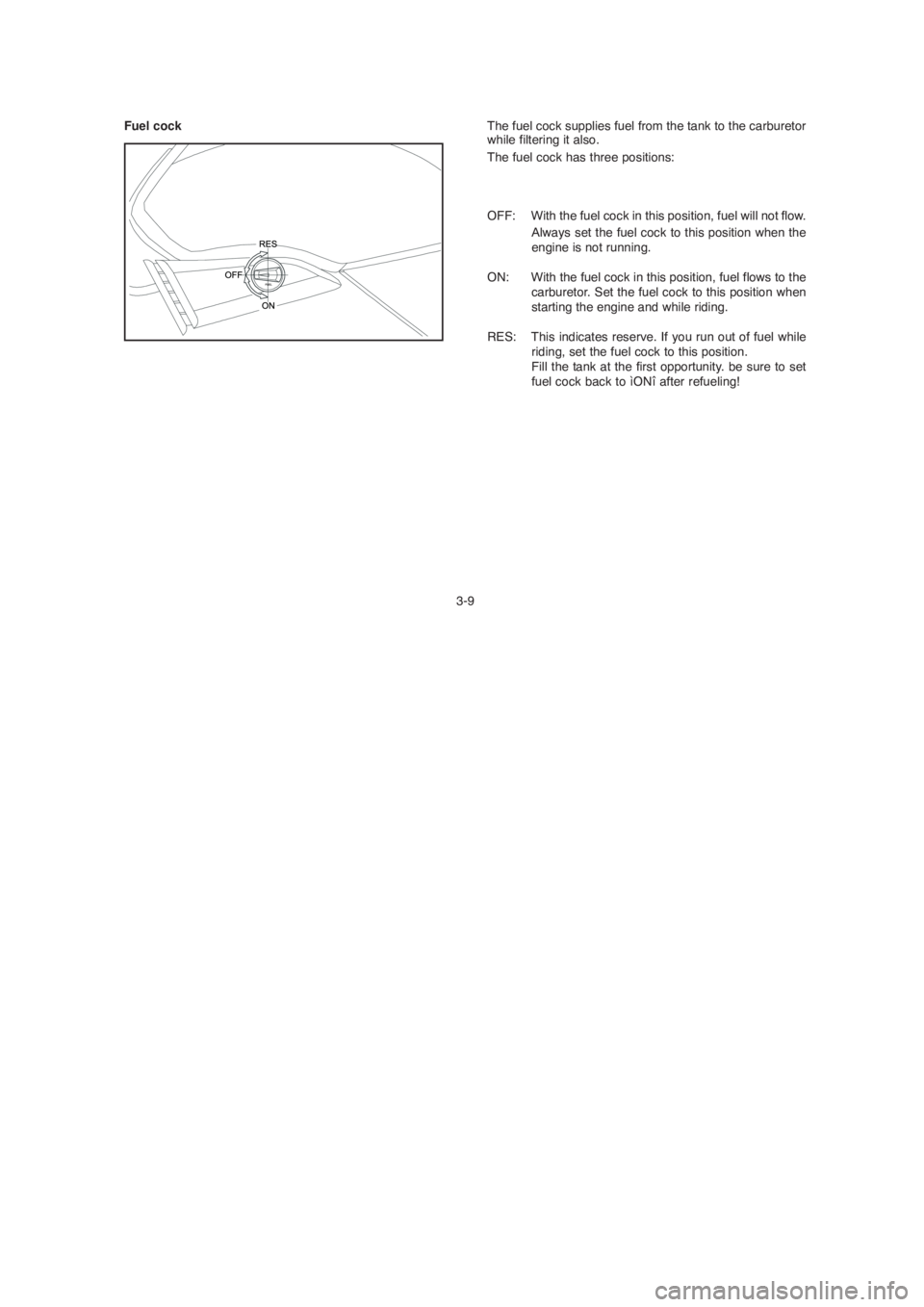
Fuel cock
3-9The fuel cock supplies fuel from the tank to the carburetor
while filtering it also.
The fuel cock has three positions:
OFF: With the fuel cock in this position, fuel will not flow.
Always set the fuel cock to this position when the
engine is not running.
ON: With the fuel cock in this position, fuel flows to the
carburetor. Set the fuel cock to this position when
starting the engine and while riding.
RES: This indicates reserve. If you run out of fuel while
riding, set the fuel cock to this position.
Fill the tank at the first opportunity. be sure to set
fuel cock back to ìONî after refueling!
Fuel cock
3-9The fuel cock supplies fuel from the tank to the carburetor
while filtering it also.
The fuel cock has three positions:
OFF: With the fuel cock in this position, fuel will not flow.
Always set the fuel cock to this position when the
engine is not running.
ON: With the fuel cock in this position, fuel flows to the
carburetor. Set the fuel cock to this position when
starting the engine and while riding.
RES: This indicates reserve. If you run out of fuel while
riding, set the fuel cock to this position.
Fill the tank at the first opportunity. be sure to set
fuel cock back to ìONî after refueling!
Page 24 of 83
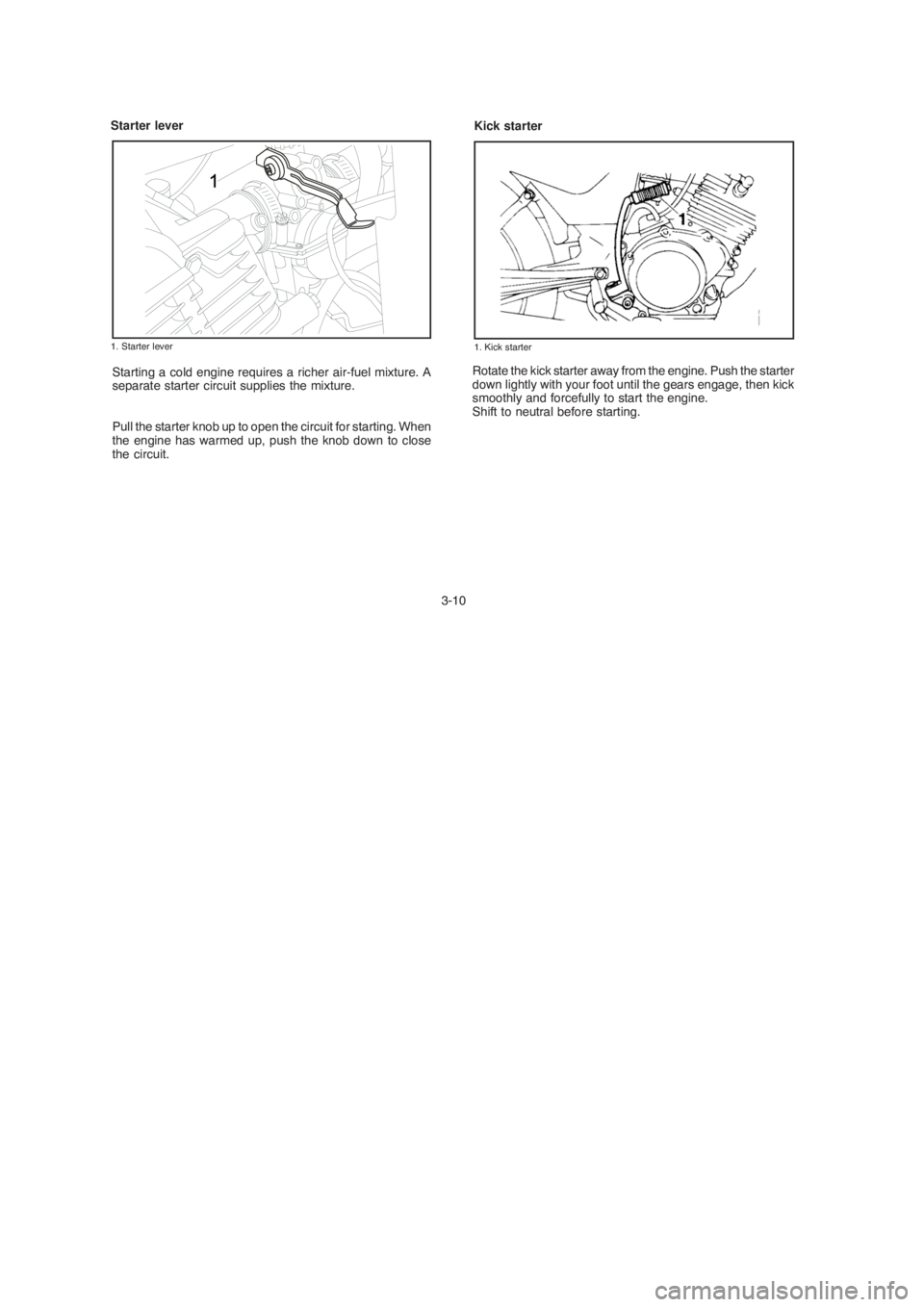
Starting a cold engine requires a richer air-fuel mixture. A
separate starter circuit supplies the mixture.
Pull the starter knob up to open the circuit for starting. When
the engine has warmed up, push the knob down to close
the circuit.
3-10 Starter lever
Rotate the kick starter away from the engine. Push the starter
down lightly with your foot until the gears engage, then kick
smoothly and forcefully to start the engine.
Shift to neutral before starting.
Kick starter
1. Starter lever
1. Kick starter
Starting a cold engine requires a richer air-fuel mixture. A
separate starter circuit supplies the mixture.
Pull the starter knob up to open the circuit for starting. When
the engine has warmed up, push the knob down to close
the circuit.
3-10 Starter lever
Rotate the kick starter away from the engine. Push the starter
down lightly with your foot until the gears engage, then kick
smoothly and forcefully to start the engine.
Shift to neutral before starting.
Kick starter
1. Starter lever
1. Kick starter
Page 29 of 83
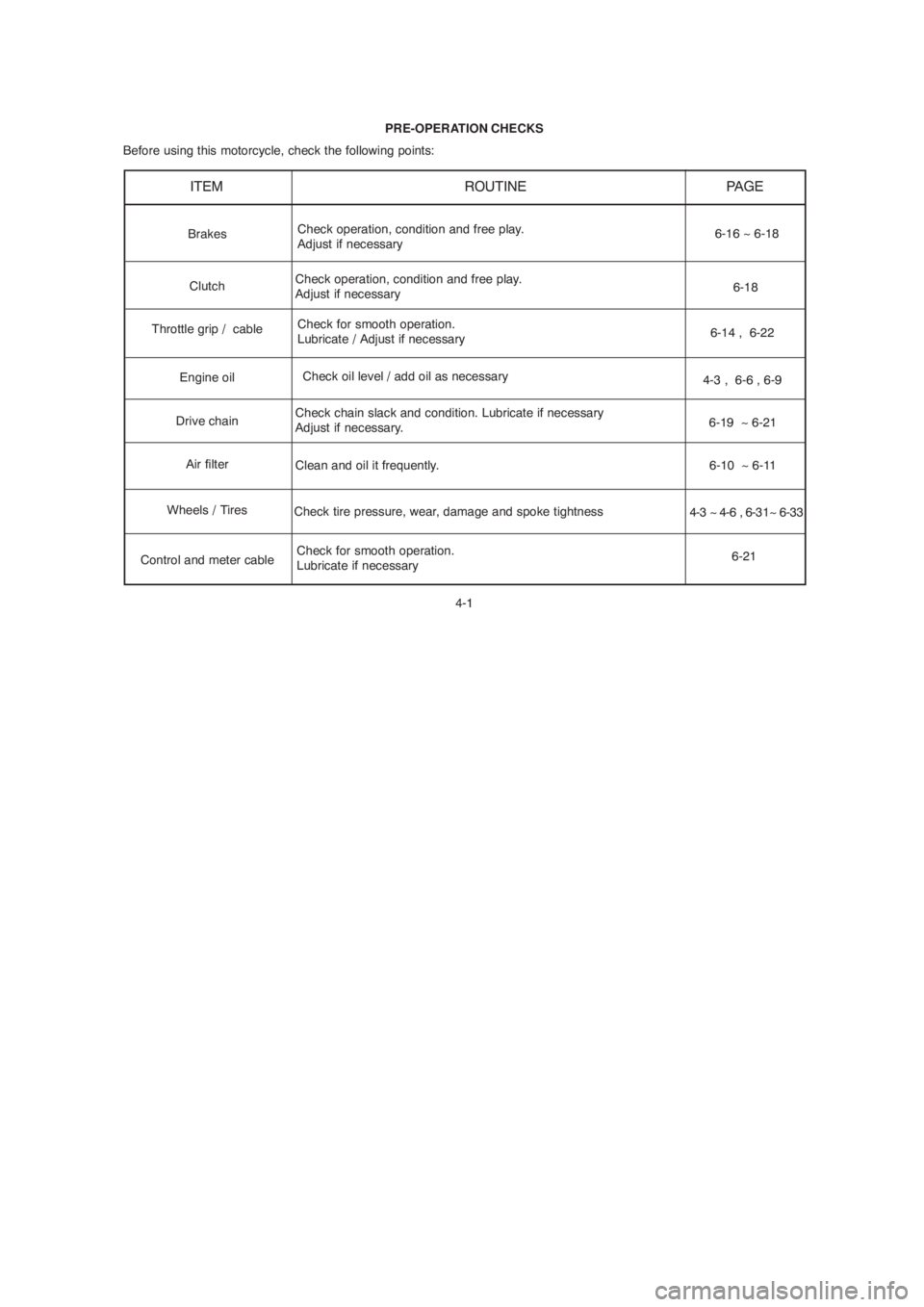
PRE-OPERATION CHECKS
Before using this motorcycle, check the following points:
ITEM ROUTINE
PAGE
Check operation, condition and free play.
Adjust if necessary
Clutch
Throttle grip / cableCheck for smooth operation.
Lubricate / Adjust if necessary
Check oil level / add oil as necessary
Engine oil
Drive chainCheck chain slack and condition. Lubricate if necessary
Adjust if necessary.
Air filter
Control and meter cableCheck tire pressure, wear, damage and spoke tightness
Check for smooth operation.
Lubricate if necessary6-16 ~ 6-18
6-14 , 6-22
4-3 , 6-6 , 6-9
6-19 ~ 6-21
6-10 ~ 6-11
4-3 ~ 4-6 , 6-31~ 6-33
6-21 Check operation, condition and free play.
Adjust if necessary
Wheels / Tires
Clean and oil it frequently.6-18 Brakes
4-1
PRE-OPERATION CHECKS
Before using this motorcycle, check the following points:
ITEM ROUTINE
PAGE
Check operation, condition and free play.
Adjust if necessary
Clutch
Throttle grip / cableCheck for smooth operation.
Lubricate / Adjust if necessary
Check oil level / add oil as necessary
Engine oil
Drive chainCheck chain slack and condition. Lubricate if necessary
Adjust if necessary.
Air filter
Control and meter cableCheck tire pressure, wear, damage and spoke tightness
Check for smooth operation.
Lubricate if necessary6-16 ~ 6-18
6-14 , 6-22
4-3 , 6-6 , 6-9
6-19 ~ 6-21
6-10 ~ 6-11
4-3 ~ 4-6 , 6-31~ 6-33
6-21 Check operation, condition and free play.
Adjust if necessary
Wheels / Tires
Clean and oil it frequently.6-18 Brakes
4-1
Page 30 of 83

4-2 NOTE:
Pre-operation checks should be made each time the motorcycle is used. Such an inspection can be thoroughly accomplished
in a very short time; and the added safety it assures is more than worth the time involved. If any maintenance service or
adjustment is needed, consult the chart above to refer to the pages in which the service or adjustment is described.
1. The engine, exhaust pipe, and muffler will be very hot after the engine has been run.
Be careful not to touch them or to allow any clothing item to contact them during inspection or repair.
2. If any item is not working properly, have it inspected and repaired before operating the motorcycle.
ITEMROUTINE
PAGE
Sidestand
Fittings / FastenersCheck all chassi fittings and fasteners.
Tighten / Adjust, if necessary
Check fuel level / top up as required.
Fuel tank
Lights, signals and switches
BatteryCheck electrolyte level.
Replenish with ìdistilled waterî if necessary.6-22
4-6 , 6-5
4-6 , 6-28 ~ 6-30
6-25 ~ 6-276-22
4-7
Check for proper operation
Front brake and clutch
lever pivotsCheck for smooth operation.
Lubricate if necessary
Check for smooth operation.
Lubricate if necessary
6-22 Check for smooth operation.
Lubricate if necessary Rear brake and shift pedal
shafts
WARNING:
4-2 NOTE:
Pre-operation checks should be made each time the motorcycle is used. Such an inspection can be thoroughly accomplished
in a very short time; and the added safety it assures is more than worth the time involved. If any maintenance service or
adjustment is needed, consult the chart above to refer to the pages in which the service or adjustment is described.
1. The engine, exhaust pipe, and muffler will be very hot after the engine has been run.
Be careful not to touch them or to allow any clothing item to contact them during inspection or repair.
2. If any item is not working properly, have it inspected and repaired before operating the motorcycle.
ITEMROUTINE
PAGE
Sidestand
Fittings / FastenersCheck all chassi fittings and fasteners.
Tighten / Adjust, if necessary
Check fuel level / top up as required.
Fuel tank
Lights, signals and switches
BatteryCheck electrolyte level.
Replenish with ìdistilled waterî if necessary.6-22
4-6 , 6-5
4-6 , 6-28 ~ 6-30
6-25 ~ 6-276-22
4-7
Check for proper operation
Front brake and clutch
lever pivotsCheck for smooth operation.
Lubricate if necessary
Check for smooth operation.
Lubricate if necessary
6-22 Check for smooth operation.
Lubricate if necessary Rear brake and shift pedal
shafts
WARNING:
Page 31 of 83

4-3
OIL QUANTITY:
Total amount:
1.2 L ( 0.264 Imp gal, 0.317 US gal)
Periodic oil change:
1.0 L ( 0.220 Imp gal, 0.264 US gal) Engine oil (See page 6-6 for details)
Make sure the engine oil is at the specified level. Add oil as
necessary.
Check the oil level in a daily manner and top it up if
necessary.
CAUTION:Tires
To ensure maximum performance, long service, and safe
operation, note the following:
1. Tire air pressure
Always check and adjust the tire pressure before
operating the machine.
Tire inflation pressure should be checked and adjusted
when the temperature of the tire equals the ambient air
temperature.
Tire inflation pressure must be adjusted according to
total weight of cargo, rider, passenger and accessories
(fairing, saddlebags, etc. if approved for this model),
and vehicle speed.
WARNING:
4-3
OIL QUANTITY:
Total amount:
1.2 L ( 0.264 Imp gal, 0.317 US gal)
Periodic oil change:
1.0 L ( 0.220 Imp gal, 0.264 US gal) Engine oil (See page 6-6 for details)
Make sure the engine oil is at the specified level. Add oil as
necessary.
Check the oil level in a daily manner and top it up if
necessary.
CAUTION:Tires
To ensure maximum performance, long service, and safe
operation, note the following:
1. Tire air pressure
Always check and adjust the tire pressure before
operating the machine.
Tire inflation pressure should be checked and adjusted
when the temperature of the tire equals the ambient air
temperature.
Tire inflation pressure must be adjusted according to
total weight of cargo, rider, passenger and accessories
(fairing, saddlebags, etc. if approved for this model),
and vehicle speed.
WARNING:
Page 34 of 83

4-6
1. It is dangerous to ride with a worn-out tire. When
the tire tread begin to show signs of wear, replace
the tire immediately. Brakes, tires and related wheel
parts should be left to a Yamaha dealer.
2. Patching a punctured tube is not recommended. If
it is absolutely necessary to do so, use great care
and replace the tube as soon as possible with a
good quality replacement.
Fitting/Fasteners
Alway check the tightness of chassis fittings and fasteners
before a ride. Use the chart on page 6-5 to find the correct
torque.
Switches
Check the operation of the starter switch, main switch,
ì Engine Stopî switch.
WARNING:Wheels
To ensure maximum performance, long service, and safe
operation, note the following:
1. Always inspect the wheels before a ride. Check for
cracks, bends, or warpage of the wheel; be sure the
spokes are tight and undamaged. If any abnormal
condition exists in a wheel, consult a Yamaha dealer or
other qualified mechanic. Do not attempt even small
repairs to the wheel. If a wheel is deformed or cracked,
it must be replaced.
2. Tires and wheels should be balanced whenever either
one is changed or replaced. Failure to have a wheel
balanced can result in poor performance, adverse
handling characteristics, and shortened tire life.
3. After installing a tire, ride conservatively to allow the
tire to seat itself on the rim properly. Failure to allow
proper seating may cause tire failure, resulting in
damage to the motorcycle and injury to the rider.
4-6
1. It is dangerous to ride with a worn-out tire. When
the tire tread begin to show signs of wear, replace
the tire immediately. Brakes, tires and related wheel
parts should be left to a Yamaha dealer.
2. Patching a punctured tube is not recommended. If
it is absolutely necessary to do so, use great care
and replace the tube as soon as possible with a
good quality replacement.
Fitting/Fasteners
Alway check the tightness of chassis fittings and fasteners
before a ride. Use the chart on page 6-5 to find the correct
torque.
Switches
Check the operation of the starter switch, main switch,
ì Engine Stopî switch.
WARNING:Wheels
To ensure maximum performance, long service, and safe
operation, note the following:
1. Always inspect the wheels before a ride. Check for
cracks, bends, or warpage of the wheel; be sure the
spokes are tight and undamaged. If any abnormal
condition exists in a wheel, consult a Yamaha dealer or
other qualified mechanic. Do not attempt even small
repairs to the wheel. If a wheel is deformed or cracked,
it must be replaced.
2. Tires and wheels should be balanced whenever either
one is changed or replaced. Failure to have a wheel
balanced can result in poor performance, adverse
handling characteristics, and shortened tire life.
3. After installing a tire, ride conservatively to allow the
tire to seat itself on the rim properly. Failure to allow
proper seating may cause tire failure, resulting in
damage to the motorcycle and injury to the rider.
Page 35 of 83
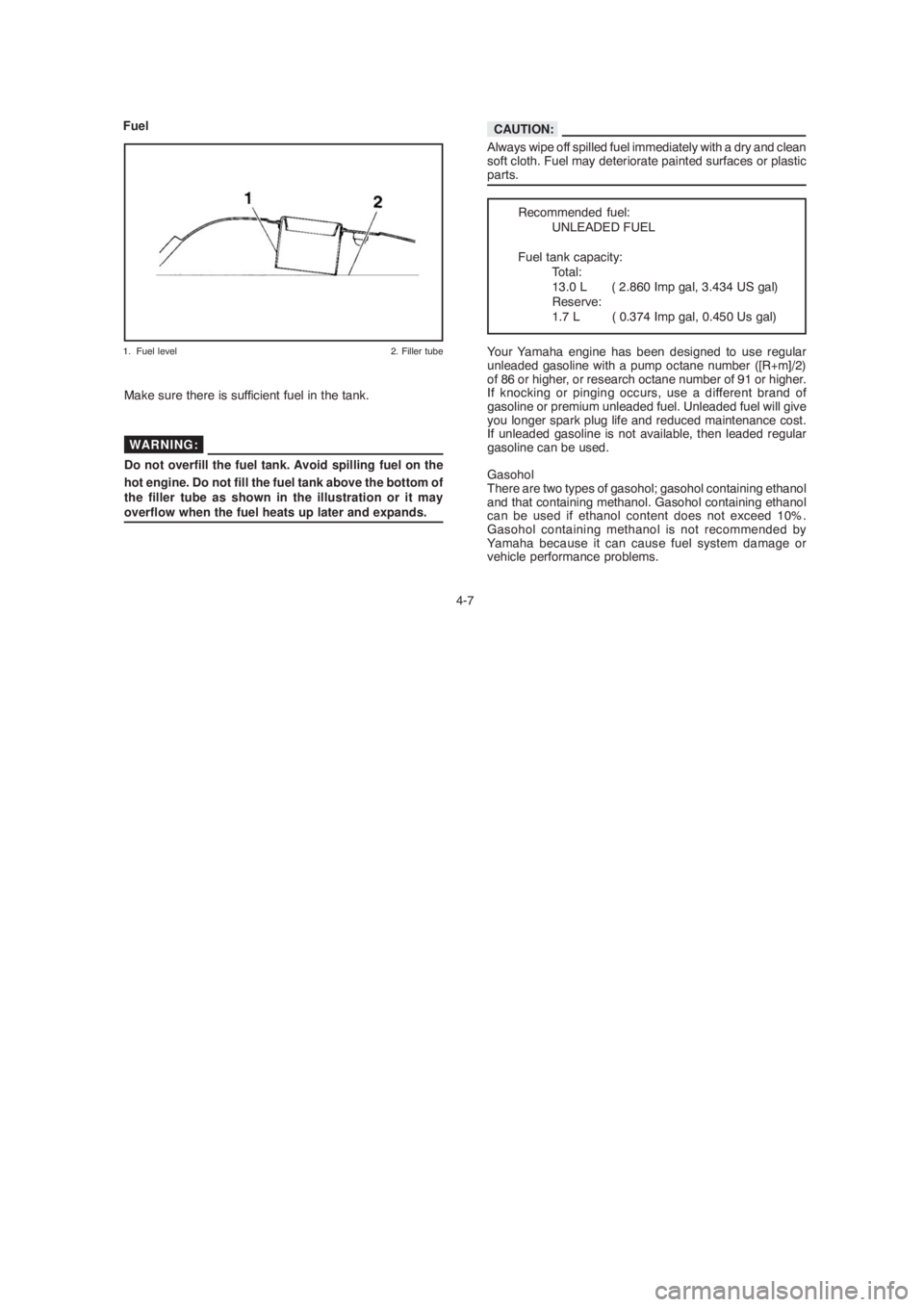
4-7Always wipe off spilled fuel immediately with a dry and clean
soft cloth. Fuel may deteriorate painted surfaces or plastic
parts. Fuel
1. Fuel level 2. Filler tube
Make sure there is sufficient fuel in the tank.
Do not overfill the fuel tank. Avoid spilling fuel on the
hot engine. Do not fill the fuel tank above the bottom of
the filler tube as shown in the illustration or it may
overflow when the fuel heats up later and expands.
Recommended fuel:
UNLEADED FUEL
Fuel tank capacity:
Total:
13.0 L ( 2.860 Imp gal, 3.434 US gal)
Reserve:
1.7 L ( 0.374 Imp gal, 0.450 Us gal)
WARNING:
CAUTION:
Your Yamaha engine has been designed to use regular
unleaded gasoline with a pump octane number ([R+m]/2)
of 86 or higher, or research octane number of 91 or higher.
If knocking or pinging occurs, use a different brand of
gasoline or premium unleaded fuel. Unleaded fuel will give
you longer spark plug life and reduced maintenance cost.
If unleaded gasoline is not available, then leaded regular
gasoline can be used.
Gasohol
There are two types of gasohol; gasohol containing ethanol
and that containing methanol. Gasohol containing ethanol
can be used if ethanol content does not exceed 10%.
Gasohol containing methanol is not recommended by
Yamaha because it can cause fuel system damage or
vehicle performance problems.
4-7Always wipe off spilled fuel immediately with a dry and clean
soft cloth. Fuel may deteriorate painted surfaces or plastic
parts. Fuel
1. Fuel level 2. Filler tube
Make sure there is sufficient fuel in the tank.
Do not overfill the fuel tank. Avoid spilling fuel on the
hot engine. Do not fill the fuel tank above the bottom of
the filler tube as shown in the illustration or it may
overflow when the fuel heats up later and expands.
Recommended fuel:
UNLEADED FUEL
Fuel tank capacity:
Total:
13.0 L ( 2.860 Imp gal, 3.434 US gal)
Reserve:
1.7 L ( 0.374 Imp gal, 0.450 Us gal)
WARNING:
CAUTION:
Your Yamaha engine has been designed to use regular
unleaded gasoline with a pump octane number ([R+m]/2)
of 86 or higher, or research octane number of 91 or higher.
If knocking or pinging occurs, use a different brand of
gasoline or premium unleaded fuel. Unleaded fuel will give
you longer spark plug life and reduced maintenance cost.
If unleaded gasoline is not available, then leaded regular
gasoline can be used.
Gasohol
There are two types of gasohol; gasohol containing ethanol
and that containing methanol. Gasohol containing ethanol
can be used if ethanol content does not exceed 10%.
Gasohol containing methanol is not recommended by
Yamaha because it can cause fuel system damage or
vehicle performance problems.
Page 36 of 83
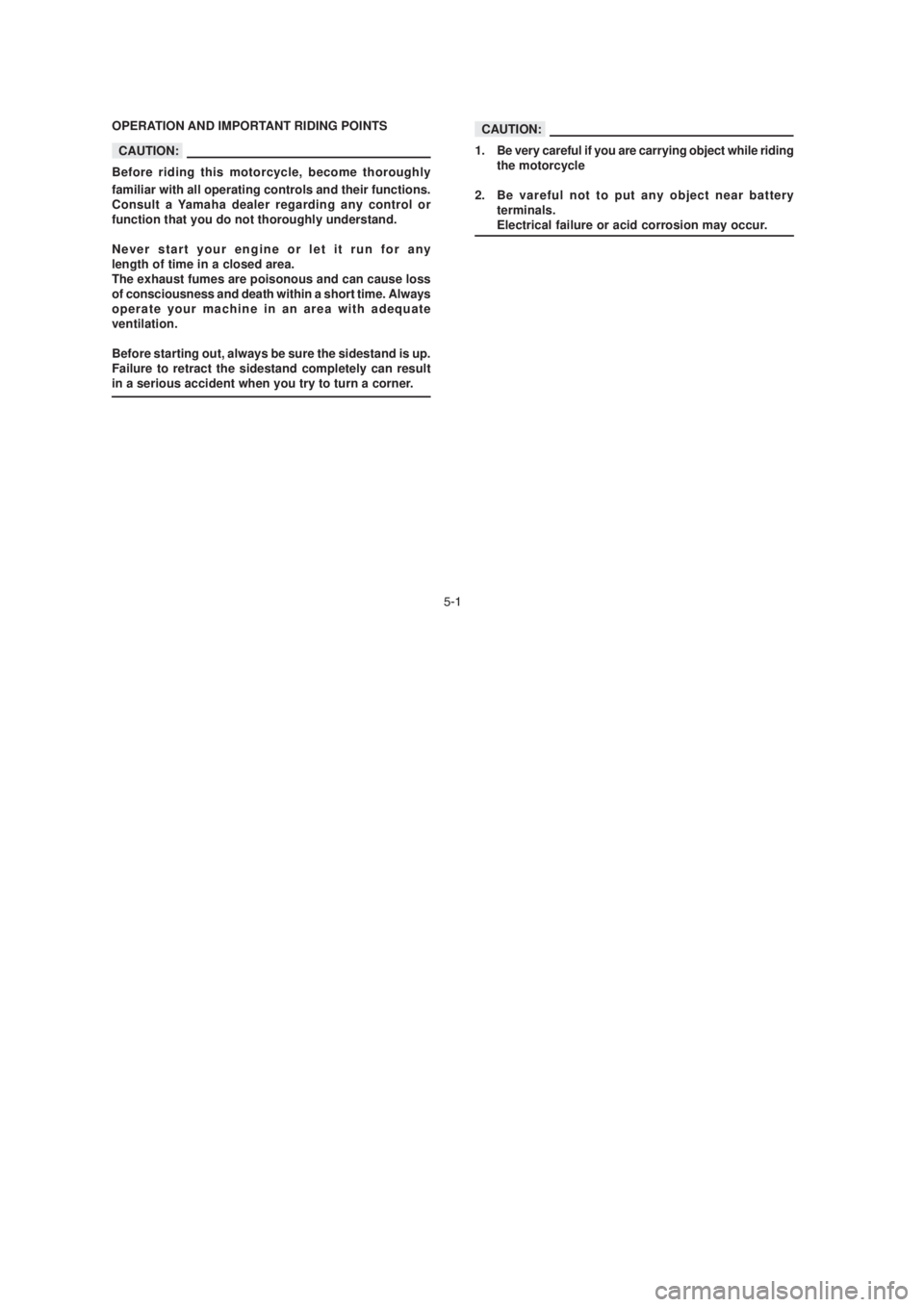
5-11. Be very careful if you are carrying object while riding
the motorcycle
2. Be vareful not to put any object near battery
terminals.
Electrical failure or acid corrosion may occur.
OPERATION AND IMPORTANT RIDING POINTS
Before riding this motorcycle, become thoroughly
familiar with all operating controls and their functions.
Consult a Yamaha dealer regarding any control or
function that you do not thoroughly understand.
Never start your engine or let it run for any
length of time in a closed area.
The exhaust fumes are poisonous and can cause loss
of consciousness and death within a short time. Always
operate your machine in an area with adequate
ventilation.
Before starting out, always be sure the sidestand is up.
Failure to retract the sidestand completely can result
in a serious accident when you try to turn a corner.
CAUTION:
CAUTION:
5-11. Be very careful if you are carrying object while riding
the motorcycle
2. Be vareful not to put any object near battery
terminals.
Electrical failure or acid corrosion may occur.
OPERATION AND IMPORTANT RIDING POINTS
Before riding this motorcycle, become thoroughly
familiar with all operating controls and their functions.
Consult a Yamaha dealer regarding any control or
function that you do not thoroughly understand.
Never start your engine or let it run for any
length of time in a closed area.
The exhaust fumes are poisonous and can cause loss
of consciousness and death within a short time. Always
operate your machine in an area with adequate
ventilation.
Before starting out, always be sure the sidestand is up.
Failure to retract the sidestand completely can result
in a serious accident when you try to turn a corner.
CAUTION:
CAUTION:
Page 37 of 83

5-2 Starting a cold engine
1. Turn the fuel cock to ìONî.
2. Turn the main switch to ìONî and the engine stop switch
to ì ì.
3. Shift transmission into neutral.
NOTE:
When the transmission is in neutral, the neutral indicator
light should be on. If the light does not come on, ask a
Yamaha dealer to inspect it.
4. Fully open the starter (CHOKE) and completely close
the throttle grip.
5. Kick the starter to start the engine.
6. After starting the engine, turn back the starter to an
intermediate position.
NOTE:
To obtain maximum engine life and service, do not ever
thoroughly accelerate it while the engine is cold.
7. After warming up the engine, turn back the stater
(CHOKE) completely.
NOTE:
The engine is warm when it responds normally to the throttle
with the starter turned off.
Starting a warm engine
The starter lever is not required when the engine is warm.
CAUTION:
If the engine fails to start with the procedures above, try to
start again with the throttle grip opened 1/4 to 1/2.
Warming up the engine
For extended engine life always warm the engine up never
accelerate hard while the engine is cold. To check if engine
temperature is normal, rev the engine with the choke closed
and check to see if it responds normally.
CAUTION:
See the ìBreak-in sectionî prior to operating the motorcycle
for the first time.
5-2 Starting a cold engine
1. Turn the fuel cock to ìONî.
2. Turn the main switch to ìONî and the engine stop switch
to ì ì.
3. Shift transmission into neutral.
NOTE:
When the transmission is in neutral, the neutral indicator
light should be on. If the light does not come on, ask a
Yamaha dealer to inspect it.
4. Fully open the starter (CHOKE) and completely close
the throttle grip.
5. Kick the starter to start the engine.
6. After starting the engine, turn back the starter to an
intermediate position.
NOTE:
To obtain maximum engine life and service, do not ever
thoroughly accelerate it while the engine is cold.
7. After warming up the engine, turn back the stater
(CHOKE) completely.
NOTE:
The engine is warm when it responds normally to the throttle
with the starter turned off.
Starting a warm engine
The starter lever is not required when the engine is warm.
CAUTION:
If the engine fails to start with the procedures above, try to
start again with the throttle grip opened 1/4 to 1/2.
Warming up the engine
For extended engine life always warm the engine up never
accelerate hard while the engine is cold. To check if engine
temperature is normal, rev the engine with the choke closed
and check to see if it responds normally.
CAUTION:
See the ìBreak-in sectionî prior to operating the motorcycle
for the first time.
Page 38 of 83
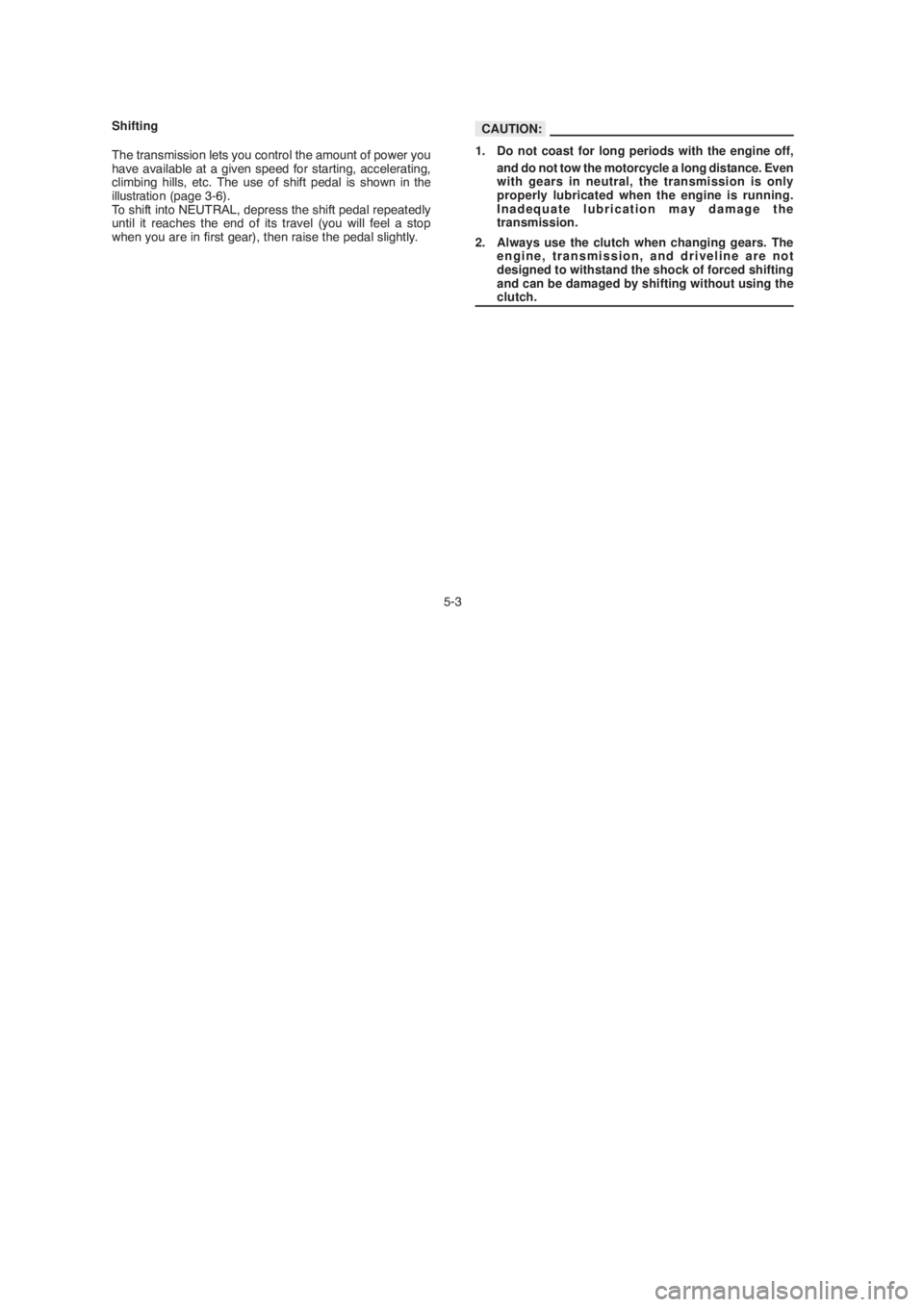
1. Do not coast for long periods with the engine off,
and do not tow the motorcycle a long distance. Even
with gears in neutral, the transmission is only
properly lubricated when the engine is running.
Inadequate lubrication may damage the
transmission.
2. Always use the clutch when changing gears. The
engine, transmission, and driveline are not
designed to withstand the shock of forced shifting
and can be damaged by shifting without using the
clutch.
5-3 Shifting
The transmission lets you control the amount of power you
have available at a given speed for starting, accelerating,
climbing hills, etc. The use of shift pedal is sho
wn in the
illustration (page 3-6).
To shift into NEUTRAL, depress the shift pedal repeatedly
until it reaches the end of its travel (you will feel a stop
when you are in first gear), then raise the pedal slightly.
CAUTION:
1. Do not coast for long periods with the engine off,
and do not tow the motorcycle a long distance. Even
with gears in neutral, the transmission is only
properly lubricated when the engine is running.
Inadequate lubrication may damage the
transmission.
2. Always use the clutch when changing gears. The
engine, transmission, and driveline are not
designed to withstand the shock of forced shifting
and can be damaged by shifting without using the
clutch.
5-3 Shifting
The transmission lets you control the amount of power you
have available at a given speed for starting, accelerating,
climbing hills, etc. The use of shift pedal is sho
wn in the
illustration (page 3-6).
To shift into NEUTRAL, depress the shift pedal repeatedly
until it reaches the end of its travel (you will feel a stop
when you are in first gear), then raise the pedal slightly.
CAUTION: